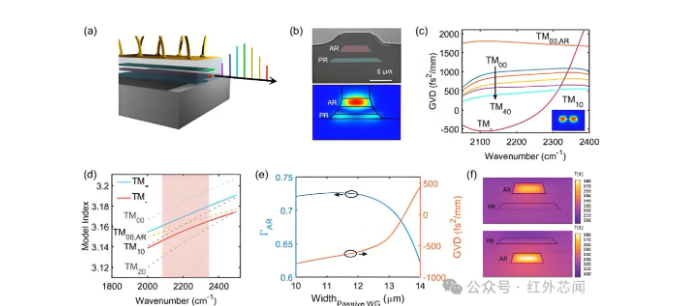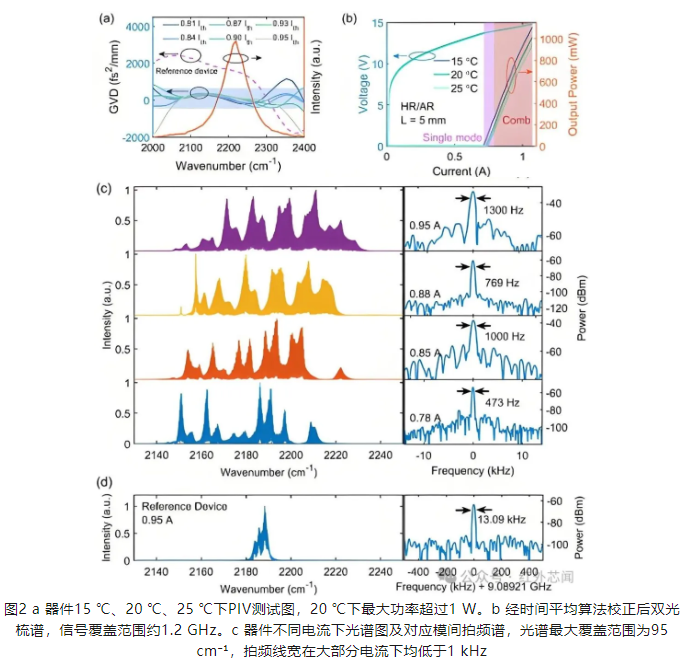13
2024
-
12
New Advances in On-Chip Mid-Infrared Frequency Combs
Author:
Quantum cascade laser frequency comb (QCL-FC) is an emerging solid-state source of radiation in the mid-infrared to terahertz band, which has significant application value in fields such as rapid spectroscopy, sensing, and laser radar.
According to a report by Mems Consulting, recently, the team of Lu Quanyong from the Beijing Quantum Information Science Research Institute (hereinafter referred to as the Quantum Institute) collaborated with the team of Liu Fengqi from the Institute of Semiconductors, Chinese Academy of Sciences, to make important progress in the research of high-power mid-wave infrared quantum cascade laser optical frequency combs, laying the foundation for further achieving high-precision on-chip sensing. The related research results were published under the title 'Monolithic dispersion engineered mid-infrared quantum cascade laser frequency comb' inPhotonics Researchjournal.
The design of the active region based on intersubband transitions enables QCL to have fast gain characteristics, allowing it to enter a multi-longitudinal mode operating state under relatively low pumping conditions through spatial burning hole effects and the side mode gain provided by carrier occupancy grating distribution. When a sufficiently low group velocity dispersion (GVD) design is provided for the active region, the powerful nonlinearity of the QCL itself can lock the cavity modes in the optical frequency comb (FC) mode. However, due to the narrow bandgap of materials such as InGaAs in the active region, the short-wavelength 3-5 μm QCL has significant material dispersion, making it difficult for the device to self-start into the FC state, thus requiring stricter and more efficient dispersion compensation schemes.
The research team proposed a single-chip integrated multimode waveguide dispersion compensation scheme (MIMWG) based on evanescent wave coupling, which introduces a high-refractive-index InGaAs passive waveguide below the active region. The high-order transverse modes in the passive waveguide couple with the fundamental mode of the active region to generate supermodes with low group velocity dispersion. Through appropriate waveguide design, this supermode can be more confined within the active region to achieve device operation in a low dispersion state, as shown in Figure 1.

This excellent heat dissipation design and effective dispersion compensation scheme enable the device to emit a maximum power exceeding 1 W at room temperature, increasing the power of optical comb devices in this band by more than 10 times, with a mode spacing linewidth of less than 1 kHz and a maximum spectral coverage exceeding 95 cm⁻¹.

The dual optical comb multimode heterodyne spectrum of the device shows clear dual optical comb teeth, indicating a definite phase relationship between the teeth of the optical comb, which verifies the effectiveness of the MIMWG dispersion compensation scheme. Compared to single-mode coupled waveguides and cavity surface coating dispersion compensation mechanisms, the MIMWG scheme, due to its excellent dispersion compensation effect and good compatibility with active-passive coupling, has potential application value in mid-infrared photonic integrated circuits (PIC), on-chip sensing, and ring cavity optical comb research.
LATEST NEWS
2025-01-09
Design and Development of Full-Spectrum Photodetectors
In recent years, the booming optoelectronic industry has changed the world and extended into many aspects of life. Among them, photodetectors (PDs) with a wide response bandwidth from deep ultraviolet to visible to near-infrared serve as important optoelectronic components and play a key role in daily life.
2025-01-08
Black arsenene multi-spectral integrated field-effect transistors, aiding high-resolution imaging and enhanced secure communication.
With the development of modern communication technology, the demand for broadband, room-temperature infrared, and terahertz (THz) detectors has rapidly increased. These detectors play a crucial role in fields such as telecommunications, security inspection, non-destructive testing, and medical diagnostics. However, existing optical detectors face challenges such as high intrinsic dark current and the need for low-temperature cooling, which limit their efficiency in detecting low-energy photons. Particularly in the terahertz band, the photon energy is insufficient to excite electron transitions from the valence band maximum (VBM) to the conduction band minimum (CBM), making effective optoelectronic conversion difficult. Therefore, researchers have been seeking ultra-broadband detectors that can operate at room temperature and respond to wavelengths ranging from visible light to the terahertz band.
2024-12-30
Laser-based tiered neurons achieve high-speed reservoir computing.
Neuromorphic computing is a computational paradigm that simulates the functions and architecture of biological neurons. A single biological neuron is a powerful computational unit with information processing capabilities, information transmission abilities, and memory functions. Therefore, it is crucial to design a photonic neuromorphic processor that can truly emulate the powerful computational functions of biological neurons.
2025-01-01
Design and Development of Full-Spectrum Photodetectors
In recent years, the rapidly growing optoelectronic industry has changed the world and extended into many aspects of life. Among them, photodetectors (PDs) with a wide spectral response from deep ultraviolet to visible to near-infrared serve as important optoelectronic components and play a key role in daily life.
2024-12-31
High-sensitivity quantum dot photodetectors from deep ultraviolet to near-infrared
In recent years, the rapidly growing optoelectronic industry has changed the world and extended into many aspects of life. Among them, photodetectors (PD) with deep ultraviolet-visible-near infrared full spectrum detection response serve as important optoelectronic components, playing a key role in daily life.

